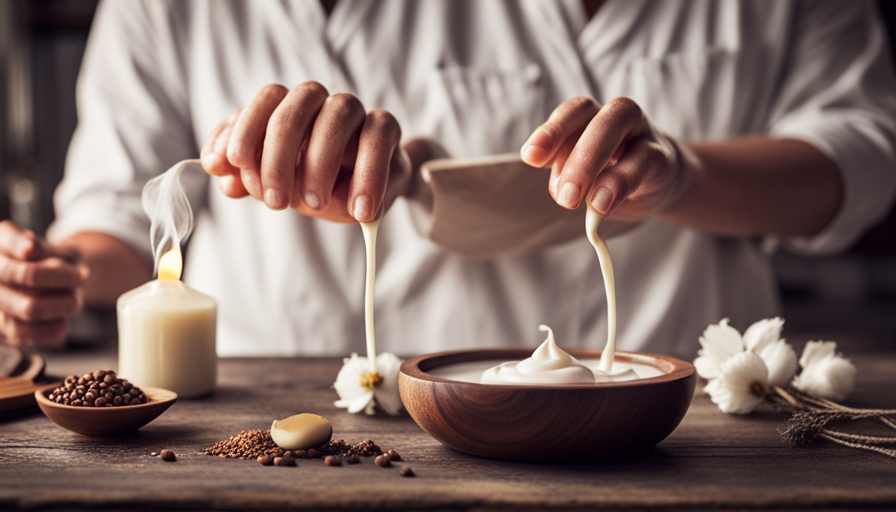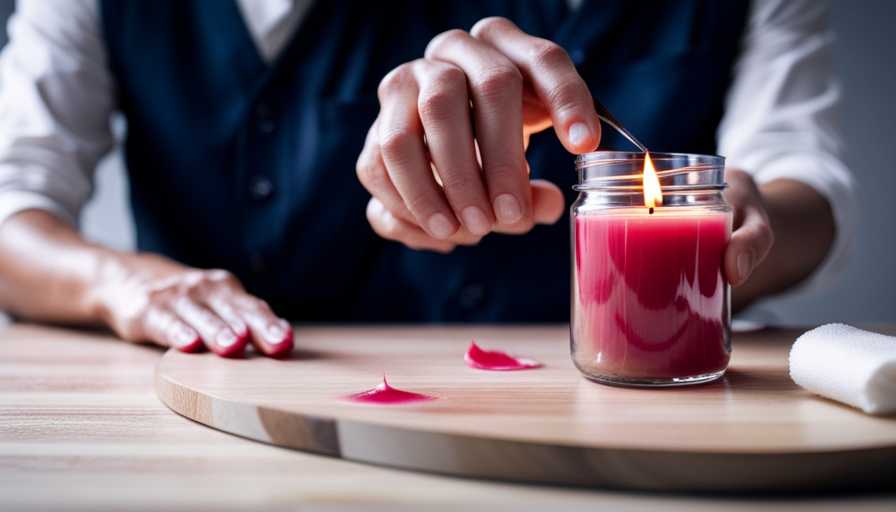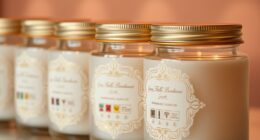Have you ever been disappointed to discover that your candle is broken? It’s like finding a crack in your favorite teacup or noticing a dent on your beloved classic car. But don’t worry, because I am here to offer my knowledge on fixing a broken candle.
With a little bit of know-how and some simple materials, you can restore your broken candle to its former glory. Whether it’s a broken wick, a cracked jar, or a candle that has lost its shape, I’ve got you covered.
In this article, I will guide you through the step-by-step process of assessing the damage, gathering the necessary supplies, and implementing various techniques to fix your broken candle. So, grab your tool kit and let’s get started on bringing your beloved candle back to life!
Key Takeaways
- Assess the damage of the broken candle before attempting repairs.
- Gather necessary supplies: heat source, adhesive suitable for candle wax, and additional reinforcement materials.
- Clean candle wax by scraping off excess wax and using an iron and brown paper bag to absorb melted wax.
- Repurpose broken candle jars as storage containers or planters if damage is too severe to repair.
Assess the Damage
Take a closer look at your broken candle, assessing the damage with a keen eye and a determined spirit. As an experienced candle enthusiast, I know the importance of evaluating the quality of the broken candle before attempting any repairs.
Examine the extent of the damage, checking for any cracks, chipped edges, or missing parts. Consider whether the candle can still be salvaged or if it’s beyond repair.
If the damage is minimal, you might be able to find alternative uses for the broken candle. For instance, you could melt down the remaining wax and pour it into smaller containers to create new candles. Alternatively, you could use the broken candle as a decorative piece, placing it in a bowl with other candles or incorporating it into a centerpiece.
However, if the damage is significant and you’re determined to fix the candle, gather the necessary supplies for the repair process. This may include a heat source like a hairdryer or a heat gun, adhesive suitable for candle wax, and any additional materials needed to reinforce the broken parts.
Assessing the damage and exploring potential uses for the broken candle is just the first step in restoring it. Now, let’s move on to gathering the necessary supplies to bring your candle back to life.
Gather the Necessary Supplies
Make sure you have all the stuff you need to get your candle back in tip-top shape. When it comes to fixing a broken candle, there are two crucial steps: cleaning the wax and trimming the wick. To clean candle wax, you will need a butter knife, a brown paper bag, and an iron. First, gently scrape off any excess wax using the butter knife. Then, place a brown paper bag over the wax residue and set your iron to a low heat. Carefully iron over the bag, allowing the heat to melt the wax and absorb it into the paper. Repeat this process until all the wax is gone.
Now, let’s move on to trimming the wick. For this, you will need a pair of sharp scissors or a wick trimmer. Ensure the wick is no longer than ¼ inch before lighting the candle. This will help prevent excessive smoke and uneven burning. Trim the wick by cutting it straight across, making sure to remove any charred or uneven sections.
Once you have successfully cleaned the wax and trimmed the wick, you can proceed to the next step of reattaching a broken wick.
Reattach a Broken Wick
Once you’ve gathered all the necessary supplies, it’s time to address the challenge of reattaching a severed wick and restoring your candle to its former glory. Reattaching a wick may seem daunting at first, but with a little patience and know-how, you can troubleshoot common wick issues and successfully fix your broken candle.
To reattach a wick, start by cleaning the area around the severed end with a damp cloth to remove any debris or wax residue. Next, take a small amount of candle wax and melt it using a heat source, such as a lighter or a candle. Carefully dip the severed end of the wick into the melted wax, ensuring that it’s fully coated. Then, quickly press the coated end onto the center of the candle, holding it firmly in place for a few seconds until the wax sets.
If the wick isn’t still secure, you can try using a wick tab or a small piece of metal to hold it in place. Simply attach the tab or metal piece to the bottom of the candle jar and thread the wick through it before reattaching it to the candle.
With the wick successfully reattached, you can now move on to fixing a cracked or broken candle jar.
Fix a Cracked or Broken Candle Jar
First, you’ll want to assess the extent of the damage to your candle jar and determine if it can be salvaged. If you notice any cracks or breaks in the jar, don’t worry because there are ways to fix it.
One method is to use heat-resistant adhesive or epoxy to bond the cracked pieces back together. Apply the adhesive to the broken edges and press them firmly together until they’re securely attached. Allow the adhesive to dry completely before using the candle again.
Alternatively, if the cracks are too severe or if you prefer not to repair the jar, there are alternative uses for broken candle jars. You can repurpose them as storage containers for small items like jewelry, buttons, or even as planters for small succulents.
In the next section, I’ll guide you on how to repair a candle that has lost its shape, ensuring that you can continue to enjoy your favorite candles for a long time.
Repair a Candle that has Lost its Shape
Don’t fret if your beloved candle has lost its shape; there’s a simple solution to restore it to its former glory. To repair a candle that has lost its shape, you’ll need a few basic supplies and a little bit of patience. First, gather a hairdryer, a heat-resistant surface, and a clean cloth. Place the candle on the heat-resistant surface and turn on the hairdryer to its highest setting. Hold the hairdryer about 6 inches away from the candle and move it around in a circular motion, evenly heating the wax. As the wax starts to soften, use the clean cloth to gently reshape the candle back into its desired form. Be careful not to apply too much pressure or the candle may crack. Once you’re satisfied with the shape, let the candle cool and harden before lighting it again.
Incorporating these keywords, you can effortlessly repair a candle that has lost its shape. Reshaping a misshapen candle is a simple process that only requires a few supplies and some care.
Transitioning into the subsequent section about ‘melt and recast a broken candle,’ you can take your candle repair skills to the next level by learning how to salvage and repurpose broken candles.
Melt and Recast a Broken Candle
Transform your candle into a work of art by melting it down and giving it a brand new shape. When a candle breaks, it can be disheartening, but don’t throw it away just yet. With some molding techniques, you can salvage your broken candle and create something unique.
First, gather your broken candle pieces and place them in a heat-resistant container. Then, heat the pieces in a double boiler until they melt completely. Once melted, carefully pour the liquid wax into a silicone mold of your choice. Allow the wax to cool and solidify, and voila! You’ve got a brand new candle with a fresh shape.
But melting and recasting your broken candle doesn’t have to stop at creating a new candle. You can also explore alternative uses for the melted wax. For instance, you can pour the wax into smaller molds to create wax melts or wax tarts. These can be used in wax warmers to fill your space with a delightful fragrance. Additionally, you can use the melted wax to make wax seals for letters or to create your own custom-made wax crafts.
So, before you consider throwing away your broken candle, think about the possibilities of melting it down and giving it a new life.
In the next section, we’ll explore how to reuse the wax from a broken candle in an eco-friendly manner.
Reuse the Wax from a Broken Candle
To give your damaged candle a new purpose, why not find creative ways to repurpose the melted wax? When a candle breaks, you can salvage the wax and use it for various candle wax crafts. Repurposing broken candles not only saves money but also allows you to create unique and personalized items. Here are some ideas to inspire you:
| Column 1 | Column 2 | Column 3 | Column 4 | Column 5 |
|---|---|---|---|---|
| Make new candles | Wax melts | Fire starters | Sealing envelopes | Wax art projects |
By repurposing the wax, you can make new candles by melting it down and pouring it into a new mold or container. You can also create wax melts, which are scented wax cubes that you can use in a wax warmer. Another option is to make fire starters by combining the melted wax with sawdust or dryer lint. These fire starters are great for camping or starting a cozy fire at home. Additionally, melted wax can be used to seal envelopes or create unique wax art projects.
Now that you know how to repurpose broken candles, let’s learn how to create a new wick for a candle.
Create a New Wick for a Candle
If you’re looking to breathe new life into your favorite candle, why not learn how to create a fresh wick? It’s just like giving a candle a new beating heart. Creating a homemade wick is a great way to troubleshoot any wick issues you may be experiencing.
To start, gather some cotton string or twine and cut it to the desired length, making sure it’s a bit longer than the height of your candle. Next, dip the string in melted wax and let it soak up the liquid. Once it’s dried, trim the wick to the appropriate length.
Now, you have a brand new wick ready to be used in your broken candle.
Creating a homemade wick can be a meticulous process, but it’s well worth the effort to salvage your beloved candle. By taking the time to troubleshoot any wick issues and create a new wick, you can ensure that your candle will continue to burn beautifully.
With a fresh wick in place, you can now move on to enhancing the scent of your broken candle.
Enhance the Scent of a Broken Candle
Elevate the fragrance of your ailing candle by infusing it with essential oils or adding dried herbs for a delightful aromatic experience. Improving the scent of a broken candle is a simple and effective way to breathe new life into it.
When it comes to enhancing the fragrance, there are a few alternative solutions you can try. First, consider adding a few drops of essential oil to the melted wax of the candle. Choose an oil that complements the existing scent or opt for a completely different aroma to create a unique blend. Lavender, citrus, or vanilla are popular choices that can instantly uplift the atmosphere.
Another option is to incorporate dried herbs into the candle. Crushed rose petals, cinnamon sticks, or dried lavender can infuse the wax with a subtle yet captivating scent. Simply sprinkle the herbs onto the melted wax and allow them to settle before re-lighting the candle.
By following these techniques, you can significantly improve the fragrance of your broken candle and enjoy a renewed aromatic experience. Now, let’s move on to the next section about properly storing and maintaining candles for longevity.
Properly Store and Maintain Candles for Longevity
Ensure your candles are stored in a cool, dry place away from direct sunlight to preserve their fragrance and prolong their lifespan. Proper candle storage is essential in maintaining their quality and preventing them from becoming damaged or losing their scent prematurely. Here are some candle storage tips and maintenance techniques to ensure your candles last as long as possible.
Firstly, it is important to store your candles in a cool and dry place. Excessive heat can cause the wax to melt or soften, while moisture can lead to mold growth or discoloration. Additionally, keep your candles away from direct sunlight as it can fade the colors and affect the fragrance.
Secondly, consider using airtight containers or zip-top bags to protect your candles from dust and debris. This will also help retain their scent and prevent any foreign odors from affecting them.
Lastly, when handling and maintaining your candles, always trim the wick to about ¼ inch before each use. This will help prevent smoking, soot, and uneven burning. Additionally, ensure the candle is placed on a heat-resistant surface and never leave it unattended while lit.
By following these candle storage tips and maintenance techniques, you can enjoy your favorite candles for a longer period, creating a cozy and inviting atmosphere in your home.
Frequently Asked Questions
Can I use any type of glue to reattach a broken wick?
No, you shouldn’t use glue to reattach a broken wick. Glue isn’t designed to withstand heat and may release harmful fumes when the candle is lit. Instead, consider using alternative methods for repairing a broken wick. One option is to replace the broken wick with a new one. Another option is to melt the wax around the broken wick and reposition it using a wick centering device. Both methods ensure a safe and effective fix for your broken candle.
Can I use a hairdryer to melt and reshape a broken candle?
To reshape a broken candle, I wouldn’t recommend using a hairdryer as it may not provide even heat distribution and could potentially damage the wax. Instead, I suggest using alternative candle repair techniques.
One method is to carefully warm the candle using a double boiler or hot water bath. This will help soften the wax, allowing you to reshape it gently with your hands or a tool. Always exercise caution when working with heat and melted wax.
How can I remove the excess wax from a cracked or broken candle jar?
To remove excess wax from a cracked or broken candle jar, there are a few wax removal techniques you can try.
First, place the jar in the freezer for a couple of hours. This will harden the wax, making it easier to chip off.
Another option is to use a hairdryer to melt the wax and then wipe it away with a cloth.
If the jar is heat-resistant, you can also place it in a warm oven to melt the wax.
Once the excess wax is removed, you can then focus on repairing the cracked candle jar.
Can I use any type of wax to recast a broken candle?
Yes, you can use different types of wax to recast a broken candle. However, it’s important to choose a wax that’s compatible with the original candle wax to ensure a seamless repair.
Some alternatives to recasting include using adhesive wax or a candle repair kit, which can be effective in fixing minor cracks or chips.
Additionally, candle repair tips such as using heat to melt and reshape the wax can also help restore a broken candle to its original form.
What can I do if my candle loses its scent after it breaks?
To restore the scent of a broken candle, there are alternative methods you can try. One option is to add a few drops of essential oil to the melted wax and stir it well before pouring it back into the container.
Another method is to place the broken candle in a sealed bag with a scented sachet or cotton ball soaked in fragrance oil for a few days.
To prevent candles from losing their scent after breaking, store them in a cool, dry place and avoid exposing them to sunlight or heat.
Conclusion
In conclusion, don’t despair when you find yourself with a broken candle. With a little know-how and a touch of TLC, you can easily fix and revive your beloved wax creations.
Remember to assess the damage, gather the necessary supplies, and carefully reattach the broken wick or fix a cracked jar. Don’t let a lost shape or scent dampen your spirits! Get creative and reuse the wax or create a new wick.
By properly storing and maintaining your candles, you can prolong their lifespan and continue to enjoy their soothing glow. So, don’t let a broken candle dim your enthusiasm; instead, let it ignite your resourcefulness and restore your favorite scents with style and finesse!









